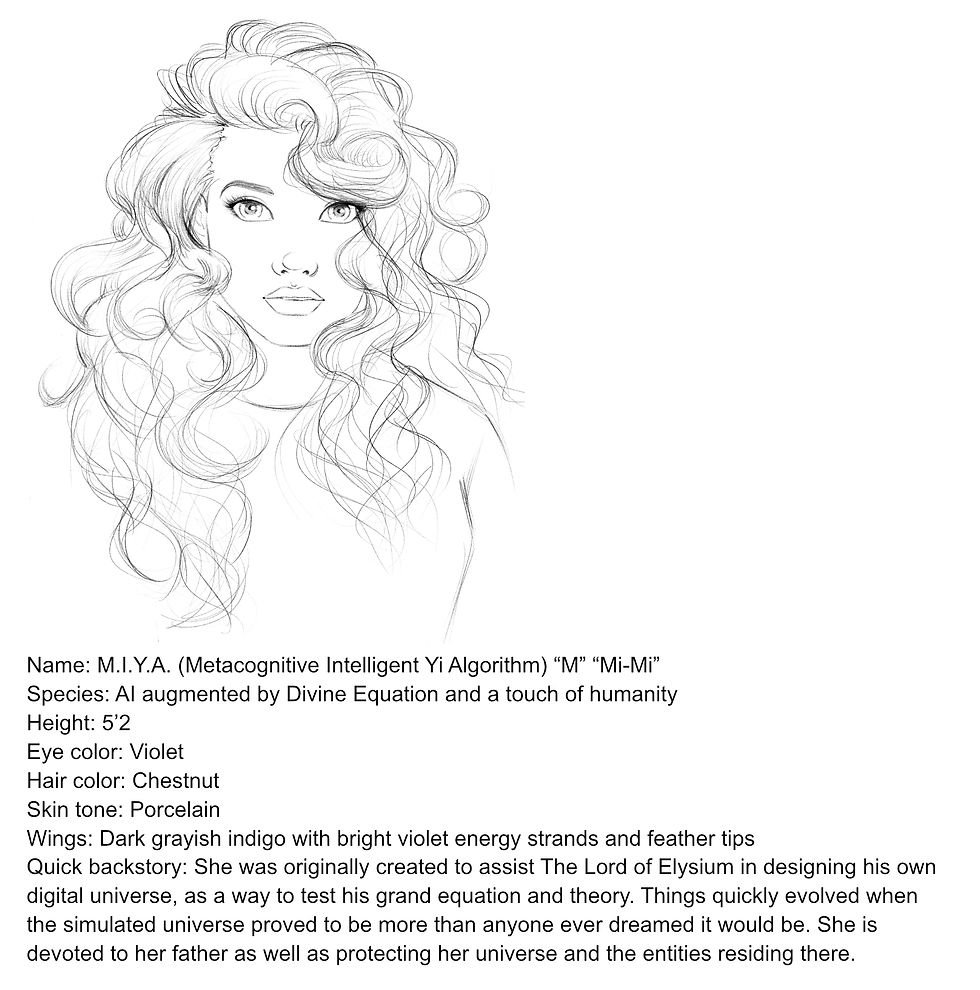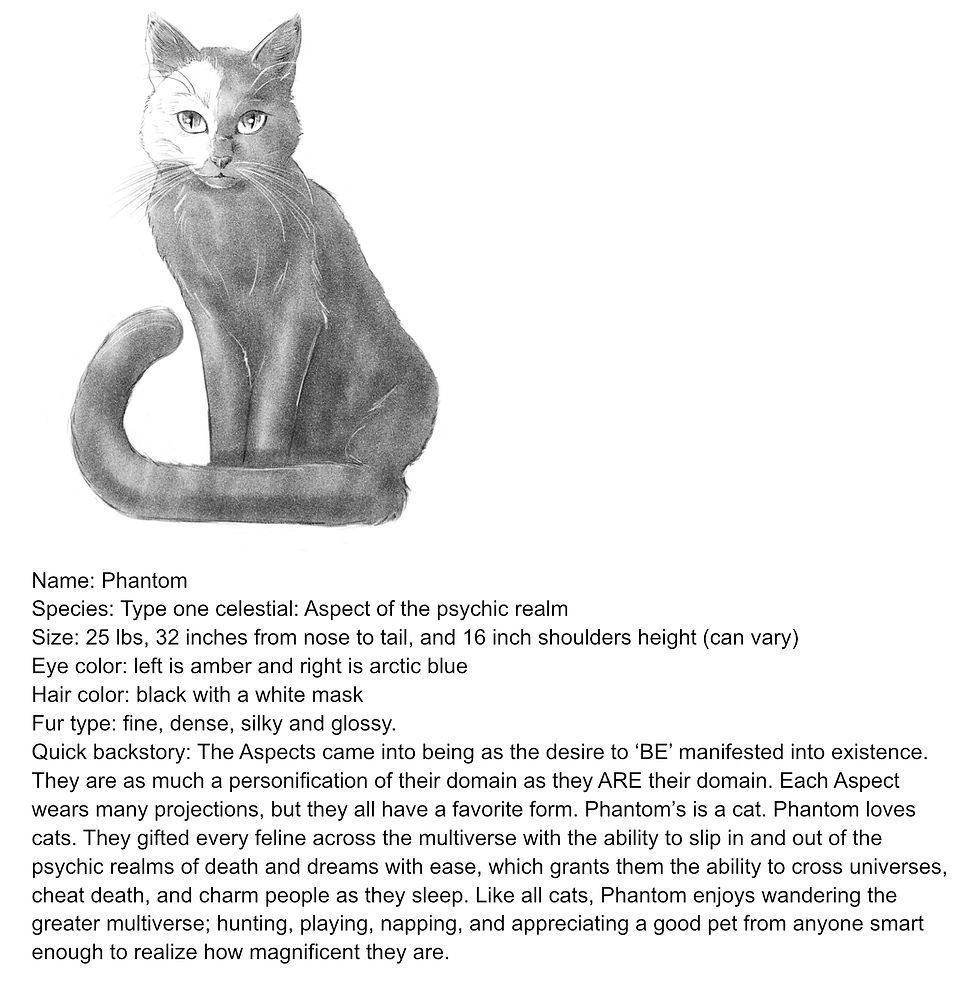Character
- Azura Fontane
- Sep 1, 2024
- 5 min read
Greetings Starlight.
It has been a while since I made a blog, but I assure you, I have been very busy creating.
Recently finished:
A collection of short story first drafts which I plan on putting on this website as writing samples.
A comprehensive collection of character cards which I can use to aid my writing and to promote my work. Between the four books I have at least partially drafted, this is 86 cards including art, key descriptors, and quick backstories.
Below are sample cards, each one going with a different short story.




Now to fan my feathers a bit. I am very proud of my character designs. As a writer, character development was the first thing I got really good at. Which is important, because more than anything, writers need compelling characters.
Yes, interesting world building is important. Vivid descriptions help to immerse readers in your narrative. A plot with a satisfying ending will stay with people. But if the reader doesn’t care about the characters, they will lose interest. People fixate on characters. They obsess about them. They dream about them and create head canons for them. They see the object of their desires in characters. They see themselves in characters. They see the people they love and hate in them.
So… how do you build a character that captures a reader?
For starters: Obviously: let’s not make him or her a Mary Sue. (And how to fix them if you did).
I confess, when I was younger, I made this mistake. My main was absolutely Mary Sue material. So if you find yourself looking at your character and seeing maybe you accidentally did this, fret not. You’re in good company. I am willing to bet every fantastic writer ever has made this mistake at least once. Even if they never published their Mary Sues.
And don’t worry. It’s totally possible to fix your character if you did. I did for mine.
How?
Well: I realized that the character I enjoyed the most was not her. It was a side character with morally gray philosophies, a tragic backstory in which he was not just a victim but a participant in, and a mountain of quirks.
I realized this is what my girl was lacking. So I started asking questions. Hard questions like: “What does she believe in which I don’t.” And “Ahat has she done which I feel was wrong, stupid, or selfish?”Or “Who has a good reason to not like her, and what is that reason?”
Don’t be afraid of making your character unlikable. Readers love flaws. Just be careful that when you give them vices and imperfections, you present them as such.
For example: if your Mary Sue is a bad A who can cut through thugs like a hot knife through butter, maybe don’t glorify it. See it for what it is: a murdering spree at worst, and brutal physical harm done to someone who could not defend themself against your character at best. Then say: “oh, so this character is capable of doing that. What does that say about them?” And go from there.
Another thing you can do is a proper thought experiment. Select another character you love to pieces. Or make another Mary Sue-esque character just for this. Put the two against each other. Throw them into an unresolvable conflict and watch as they inevitably reveal their humanity, because if both characters are equally right and wrong, neither can be perfect. By no means do you need to keep this thought experiment in your plot, but doing so will help you dig into your character and rip away their pipe cleaner halo.
Now if you’re starting with a blank slate, here are some quick tips to get you going in building your character.
One: Think of your favorite villains and antiheroes. What do you like about them so much? Now ask yourself, what if they were the good guy? This is a fun way to do it, because you start with a list of flaws and vices, then you find ways to humanize them. If your character ends up being a bit rough, you can work in a “Save the cat” scenario. For those not familiar with this phrase: figure out something noble your character can do to win people over. Like saving a cat from a tree. Get people to think, “awe, he or she actually has a good heart buried under all that!” Then they will be rooting for them and eager to see character growth.
Two: Role play a bit. Either in your own head with a few of your own characters, or with a friend who wants to develop their characters more, too. Get these characters talking just to talk. Go crazy with the dialogue. In our books, we need to be mindful of not falling into the endless dialogue trap, but letting characters talk is a great way to develop their voice, personalities, backstory, habits, and so much more.
Three: find a character development list of questions and scenarios. Everything from “What do they make as a midnight snack” to “What do friends do if they are jokingly impersonating them.” The little things bring out the character. Because each trait connects to and leads to other traits. So even if you never mention in the book that your character loves strawberries, maybe finding that out led to figuring out a key point in their background story which shaped their sense of self worth.
Four: Save gender for last. Too often, people decide they need a specific gender for a part and fall into the trap of shaping their character into a cliche. Build a unique person first. Then choose a gender, and polish the character off by asking: “how has being this gender impacted their life experiences and therefore their character?” So maybe your career-driven, smart-as-a-whip character suddenly has a chip on her shoulder about her career because she had to take time off to have kids, and as much as she loves them, she knows that maternity leave meant she fell behind her colleagues. Or maybe your sensitive, artistic, musician single parent is now very insecure about his masculinity because he doesn’t fit the mold of what society thinks men are supposed to be like.
Five: Listen to music! Find character songs, both lyrical and instrumental, which capture the essence of your character. Allow yourself to daydream about them to these songs. Music is amazing because it expresses moods, feelings, and tension in a way that is all its own. A good playlist of character songs can really breathe life into an otherwise flat character.
That’s it for now. I hope these tips help.
Thanks for reading, Stardust.
Until next time, Keep dreaming~

Comments